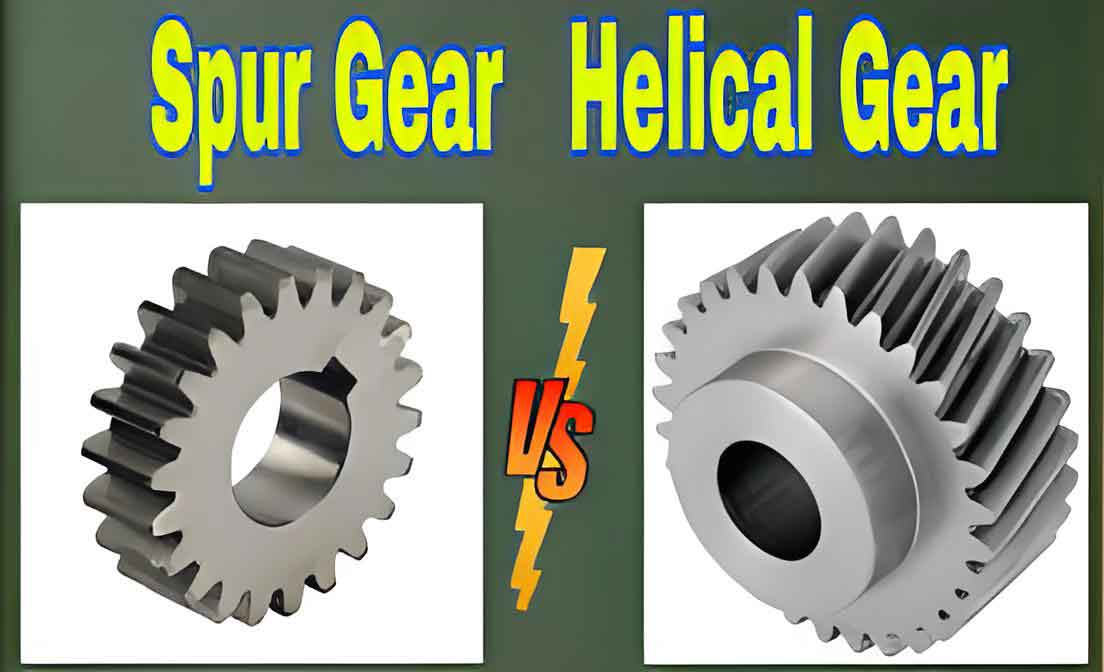Gears are fundamental components in numerous industrial applications, playing a crucial role in power transmission and mechanical systems. Among the various types of gears, spur gear and helical gear are the most commonly used in industrial applications. Understanding the differences between these two types of gears, including their design, performance characteristics, and application suitability, is essential for selecting the right gear type for specific industrial needs. This article compares spur gear and helical gear, highlighting their advantages, disadvantages, and ideal use cases in industrial applications.

Design and Characteristics
Spur Gear: Spur gear has teeth that are cut straight and parallel to the gear’s axis. This design makes spur gear simple, easy to manufacture, and highly efficient in transmitting power between parallel shafts.
Helical Gear: Helical gear has teeth that are cut at an angle to the gear axis, forming a helix shape. This design allows for gradual engagement of the teeth, resulting in smoother and quieter operation compared to spur gear. Helical gear can transmit power between parallel or non-parallel (crossed) shafts.
Table 1: Design Characteristics of Spur Gear and Helical Gear
| Characteristic | Spur Gear | Helical Gear |
|---|---|---|
| Tooth Design | Straight and parallel | Angled (helix shape) |
| Shaft Arrangement | Parallel | Parallel or non-parallel |
| Engagement | Instantaneous | Gradual |
| Manufacturing | Simple and cost-effective | More complex and expensive |
Performance Comparison
Efficiency: Spur gear is generally more efficient than helical gear due to their straightforward design, which minimizes frictional losses. However, helical gear provide smoother operation and can handle higher loads due to the gradual engagement of teeth.
Noise and Vibration: Spur gear tend to generate more noise and vibration because their teeth engage and disengage abruptly. Helical gears, with their angled teeth, offer quieter and smoother operation, making them suitable for applications where noise reduction is important.
Load Capacity: Helical gear can handle higher loads compared to spur gear because the load is distributed over multiple teeth during engagement. This makes helical gear more suitable for heavy-duty applications.
Axial Thrust: Helical gear generate axial thrust due to the angled teeth, which requires additional bearings to counteract. Spur gear do not produce axial thrust, simplifying their mounting and support requirements.
List: Performance Characteristics of Spur Gear and Helical Gear
- Efficiency:
- Spur Gear: High efficiency due to minimal frictional losses.
- Helical Gear: Slightly lower efficiency but smoother operation.
- Noise and Vibration:
- Spur Gear: Higher noise and vibration levels.
- Helical Gear: Lower noise and smoother operation.
- Load Capacity:
- Spur Gear: Moderate load capacity.
- Helical Gear: Higher load capacity.
- Axial Thrust:
- Spur Gear: No axial thrust.
- Helical Gear: Generates axial thrust.
Table 2: Performance Comparison of Spur Gear and Helical Gear
| Performance Aspect | Spur Gear | Helical Gear |
|---|---|---|
| Efficiency | High | Moderate |
| Noise and Vibration | Higher | Lower |
| Load Capacity | Moderate | Higher |
| Axial Thrust | None | Present |
Applications in Industrial Settings
Spur Gear: Due to their simplicity, high efficiency, and cost-effectiveness, spur gear is commonly used in a wide range of industrial applications, including:
- Machinery: Spur gear is extensively used in various types of machinery where high efficiency and straightforward power transmission are required.
- Conveyors: Spur gear is ideal for conveyor systems, providing reliable and efficient power transmission.
- Automotive Transmissions: Spur gear is used in automotive transmissions for their efficiency and ability to handle moderate loads.
- Power Tools: Spur gear is employed in power tools where precise and efficient power transmission is needed.
Helical Gears: Helical gear is preferred in applications requiring smooth and quiet operation, as well as high load-carrying capacity. Common industrial applications include:
- Heavy Machinery: Helical gear is suitable for heavy machinery that requires high torque and smooth operation.
- Gearboxes: Helical gear is used in gearboxes for their ability to handle higher loads and reduce noise.
- Pumps and Compressors: Helical gear is ideal for pumps and compressors where noise reduction and load capacity are critical.
- Robotics: Helical gear is used in robotics for their smooth operation and precise power transmission.
List: Typical Industrial Applications of Spur Gear and Helical Gear
- Spur Gear:
- Machinery
- Conveyors
- Automotive Transmissions
- Power Tools
- Helical Gear:
- Heavy Machinery
- Gearboxes
- Pumps and Compressors
- Robotics
Table 3: Industrial Applications of Spur Gear and Helical Gear
| Application | Spur Gear | Helical Gear |
|---|---|---|
| Machinery | High efficiency, cost-effective | Smooth operation, high load capacity |
| Conveyors | Reliable power transmission | Quieter operation |
| Automotive Transmissions | Efficient power transmission | Lower noise, better load distribution |
| Power Tools | Precise power transmission | Smooth and quiet operation |
| Heavy Machinery | Moderate load handling | High torque, smooth operation |
| Gearboxes | Cost-effective, efficient | High load capacity, reduced noise |
| Pumps and Compressors | Reliable, efficient | Noise reduction, high load capacity |
| Robotics | Precise power transmission | Smooth and precise operation |
Conclusion
In industrial applications, the choice between spur gear and helical gear depends on the specific requirements of the application. Spur gear offer high efficiency, simplicity, and cost-effectiveness, making them suitable for a wide range of uses where noise and load capacity are not critical concerns. On the other hand, helical gear provide smoother and quieter operation, higher load capacity, and are better suited for heavy-duty and noise-sensitive applications.
By understanding the design characteristics, performance differences, and ideal applications of spur gear and helical gear, engineers and designers can make informed decisions to optimize the performance and reliability of industrial machinery. As technology continues to advance, both spur gear and helical gear will remain essential components in the evolution of industrial power transmission systems.
